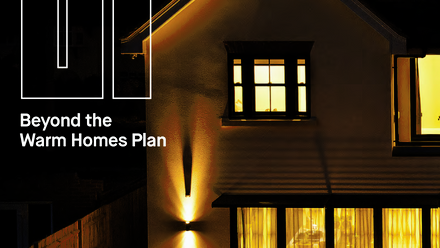Overheating in homes: how big is the problem and what can we do to mitigate the effects?
How does overheating impact people?
Hot temperatures are not just uncomfortable, but have serious health implications, especially for older people and those with existing health conditions. High temperatures raise blood pressure and heart rate, impacting the circulatory, nervous, respiratory and renal systems, which can lead to dehydration, heat exhaustion and heatstroke. In extreme cases it can lead to death: the UK Health Security Agency estimates that there were up to 3,712 deaths attributed to heat in summer 2022, the highest number in any given year.
Mental health is also impacted by hot weather as it can exacerbate the symptoms of psychiatric illnesses.
Even for those people whose health is not directly affected, hot temperatures often prevent us from getting the sleep we need and therefore have consequences for productivity. The Office for National Statistics estimates that productivity in Great Britain was reduced by an incredible £5.3 billion in 2020 due to heat.
Are our homes overheating?
Under the Chartered Institution of Building Services Engineers' (CIBSE) TM59 Design methodology for the assessment of overheating risk in homes, overheating is defined as when the internal temperature threshold of 26°C is surpassed for over 3% of the annual occupied hours, for predominantly naturally ventilated dwellings. Using the TM59 standard, a 2019 government study on overheating in homes showed that out of eight modelled house and flat typologies, not a single one met the acceptable risk criteria for overheating.
Apartments are particularly susceptible to overheating, with living rooms and bedrooms being the rooms most affected.
Not everyone is impact by overheating equally. Low income households and those living in social housing bear the brunt of overheating.
Why our our homes overheating?
The Met Office is categorical about the reason behind our increased temperatures: "UK mean temperatures have been shifting over the decades as a result of human-induced climate change".
But global warming isn't the entire story when it comes to increasing temperatures in our homes. Homes built to modern Building Regulations are better insulated and designed to be more air tight and therefore energy efficient. However, this can also lead to raised indoor temperatures.
And then there's the location of our new build homes, the majority of which are in cities. For many residents in built up urban environments, opening windows to allow cooler air in to their homes is not always an option due to noise, pollution and safety concerns.
What can we do to address overheating in our homes?
There are wide ranging means by which we can reduce heat levels in our homes.
Ensuring cities have green spaces, especially in urban areas, is an important factor as these are known to have significant cooling effects. The Urban heat mitigation by green and blue infrastructure international study has shown that botanical gardens can cool city air by 5°C, with parks and wetlands also significantly reducing air temperatures.
Whilst this level of intervention needs to be done at town planning level, housebuilders also have a role to play by adhering to Building Regulations, Approved Document O. This provides guidance on mitigating overheating in residential buildings including optimising glazing, solar shading and natural ventilation. The House of Commons' Environmental Audit Committee's fifth report of session 2023-24 on heat resilience and sustainable cooling would like to see Building Regualtions Part O be expanded to cover refurbishments of existing properties as well as material changes of use to residential. It is also calling for post-occupancy evaluation to be introduced to ascertain the real-world performance of mitigation measures taken under Part O, within the first year of installation.
Approved Document O rightly stipulates that mechanical cooling may only be used where insufficient heat is capable of being removed from the indoor environment without it. Where this is the case, a cooling hierarchy needs to be followed, which includes acoustic façade vents and mechanical ventilation through to mechanical cooling.
The latter has historically been in the form of air conditioning, but this would need to be on a site-wide basis. Mechnical ventilation systems with heat recovery (MVHR) are a further option. For many new build homes, these will be able to meet the extract ventilation rates required to help mitigate overheating in the summer if equipped with a third speed to provide a Part O purge.
However, it's well known that many housing developments have 'problem' areas when it comes to overheating, such as corner apartments which may have more glazing area relative to their internal floor area, and that get sunshine for longer. These apartments will most likely get hotter than surrounding apartments. MVHR is unlikely to succeed in keeping temperatures within the TM59 guidelines in these circumstances and installing air conditioning just to these specific apartments is not a practical solution due to the logistics of the refrigerant pipework and associated cost this brings, not to mention the necessity for centralised cooling plant. In these instances, a hybrid cooling system, such as Nuaire's MRXBOX, is a good option to consider. These new hybrid systems integrate with the MVHR system and operate in conjunction with it. It combines the heat-exchanger coolth recovery of an MHVR system with the cooling effect provided by a DX coil which significantly lowers the temperature of the fresh-air supply. The MVHR is pre-programmed to target a comfortable temperature, maximising free-cooling through its bypass when the external air is cooler than internal, and coolth recovery when hotter external air can be cooled by extracted stale air from wet-rooms. The cooling module activates automatically to lower supply air temperatures when required.
Do we need a national strategy on overheating?
The introduction of Part O represents a significant step in recognising overheating as an issue in this country, and providing actionable guidance on how to mitigate it in the design of our homes.
However, some types of development, such as material change of use whereby existing buildings are repurposed as much needed housing, are not covered and their potential risk of overheating has been undiminished by Part O's introduction.
Increasingly, organisations operating in the housing sector are calling on the government to develop a national strategy on overheating that is more ambitious than the current collection of policy and initiatives, and that introduces urgency into combatting and mitigating overheating. The UK Collaborative Centre for Housing Evidence goes as far to call for a lead Minister for heat resilience to act as a focal point and drive forward coordinated action in this area.
Creating and adopting a national heat resilience strategy isn't such a tall order. The government did, after all, sign up to the Global Cooling Pledge initiative at COP28, which has a commitment to produce a national cooling action plan. Ultimately, we will have to wait to see how seriously the government really takes the issue of overheating.





